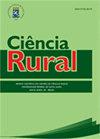Urochloabrizantha and corn or sorghum silage integrated production: agronomic evaluation, fermentation losses, and aerobic stability of silage
IF 0.9
4区 农林科学
Q3 AGRONOMY
引用次数: 0
Abstract
ABSTRACT: The present study evaluated germination, production, and morphological composition of Urochloabrizantha intercropped with corn and sorghum; and silage fermentation losses and aerobic stability of intercrop silage using microbial inoculant. Twenty experimental parcels (5.0 × 3.6 m) were used in a blocked randomized design to evaluate four treatments obtained from a 2 × 2 factorial arrangements: I) crop material (corn vs. sorghum) and II) Brachiaria (U. brizantha) establishment (present vs. absent). Corn- and sorghum-brachiaria integrated systems showed similar brachiaria germination, forage yield, and morphological composition. There was no crop and brachiaria interaction effect on the variables related to corn and sorghum plants and the total productivity. Brachiaria decreased the stem diameter and increased the population of maize and sorghum plants. However, it did not affect systems productivity. Microbial inoculation did not affect corn silage effluent losses and reduced sorghum silage effluent losses. In corn silage, brachiaria did not affect gas losses, while in sorghum silage, brachiaria increased the gas losses. Total losses were higher in sorghum silage than in corn silage, which resulted in a lower DM recovery. The treatments did not affect the pH of the silage after aerobic exposure. However, brachiaria increased silage temperature evaluated at 32 and 40 hours after aerobic exposure. Thus, corn or sorghum consortium has similar brachiaria morphological composition and productivity. Moreover, in intercropped silage, brachiaria increases effluent losses and reduces silage aerobic stability.青贮与玉米或高粱青贮的综合生产:农艺评价、发酵损失和青贮的有氧稳定性
摘要/ ABSTRACT摘要:本研究对玉米和高粱间作的臭毛草的萌发、产量和形态组成进行了研究。微生物接种剂对青贮发酵损失及间作青贮有氧稳定性的影响。20个实验地块(5.0 × 3.6 m)采用封闭随机设计,评估从2 × 2因子安排中获得的四种处理:1)作物材料(玉米vs.高粱)和II) Brachiaria (U. brizantha)建立物(存在vs.不存在)。玉米和高粱-腕足菌组合系统显示出相似的腕足菌发芽率、饲料产量和形态组成。玉米、高粱植株及总生产力相关变量均不存在作物与腕足菌互作效应。Brachiaria降低了玉米和高粱植株的茎粗,增加了植株的数量。然而,它并不影响系统的生产力。接种微生物对玉米青贮出水损失无影响,对高粱青贮出水损失有降低作用。在玉米青贮中,臂曲菌对气体损失没有影响,而在高粱青贮中,臂曲菌增加了气体损失。高粱青贮的总损失高于玉米青贮,这导致DM恢复较低。这些处理对好氧暴露后青贮饲料的pH值没有影响。然而,在有氧暴露后32和40小时,臂状螺旋体提高了青贮温度。因此,玉米和高粱组合具有相似的臂鳃形态组成和产量。此外,在间作青贮中,臂状螺旋体增加了废水损失,降低了青贮的好氧稳定性。
本文章由计算机程序翻译,如有差异,请以英文原文为准。
求助全文
约1分钟内获得全文
求助全文
来源期刊

Ciencia Rural
AGRONOMY-
CiteScore
1.70
自引率
0.00%
发文量
233
审稿时长
2-4 weeks
期刊介绍:
The purpose of Ciência Rural is to publish the results of original research, note and reviews which contribute significantly to knowledge in Agricultural Sciences. Preference will be given to original articles that develop news concepts or experimental approaches and are not merely repositories of scientific data. The decison of acceptance for publication lies with the Editors and is based on the recommendations of Editorial Comission, Area Committee and/ or ad hoc reviewers. The editors and reviewers are external to the institution.
 求助内容:
求助内容: 应助结果提醒方式:
应助结果提醒方式:


